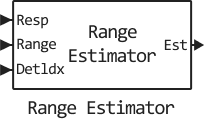Range Estimator
Range estimation.
blockType: RangeEstimator
|
Path in the library: |
Description
Block Range Estimator evaluates the target detection range obtained from the radar response data.
Ports
Entrance
Resp — cube of radar trigger data processed by pass:q range[<br>] complex column vector M by 1 | complex matrix M by N | complex matrix M by N by P
A range-processed response data cube defined as a complex column vector M by 1, a complex matrix M by P, or a complex array M by N by P. M is the number of range samples, N is the number of sensor elements or rays, and P is the number of Doppler bins.
The number of samples for the first dimension of the input matrix can be changed to simulate a change in the length of the signal. A change in size can occur, for example, in the case of a pulse waveform with a variable pulse repetition rate.
Data types: Float16, Float32, Float64, Int8, Int16, Int32, Int64, UInt8, UInt16, UInt32, UInt64, Bool
Support for complex numbers: Yes
Range — values of the pass range grid:q[<br>] a real vector is a column M by 1
The values of the range grid according to the size of the range of the input cube of the Resp data, set as a real vector column M by 1. The values of the range must be monotonically increasing and equidistant from each other. The units of measurement are meters.
Example: [-0.3,-0.2,-0.1,0,0.1,0.2,0.3]
Data types: Float16, Float32, Float64, Int8, Int16, Int32, Int64, UInt8, UInt16, UInt32, UInt64, Bool
NoisePower — noise power at the detection points of
positive scalar | real positive vector-row 1 on Q
The noise power at the detection sites, specified as a positive scalar or a real positive vector-row 1 on Q. Q is the number of detections specified in the input port DetIdx.
Dependencies
To use this port, select the Output variation for parameter checkbox and set the Source of noise power parameter to Input port.
Clusters — cluster IDs
real positive vector-row 1 on Q
Cluster identifiers specified as a real positive vector-row 1 on Q, where Q is the number of detections specified in the DetIdx input port. Each Clusters element corresponds to a DetIdx element.
Dependencies
To use this port, select the Enable cluster ID input checkbox.
Output
Est — assessment of the pass range:q[<br>] real column vector K by 1
Range estimates given as a real column vector K by 1.
If the Enable cluster ID parameter is not enabled, then each range estimate corresponds to one of the columns of the input port DetIdx. Then K is equal to the dimension of the column Q of the port DetIdx.
If the Enable cluster ID parameter is enabled, then each range estimate corresponds to one of the cluster IDs in the Clusters input port. Then K is equal to the number of unique cluster IDs.
Var — pass propagation range:q[<br>] real positive column vector K by 1
The variance of the range estimate returned as a positive real column vector K by 1, where K is the dimension Est. Each Var element corresponds to an Est element. The variance of the estimate is calculated using the Ziva-Zakai constraint.
Dependencies
To use this port, select the Output variance for parameter checkbox.
Parameters
Maximum number of estimates — maximum number of pass estimates:q[<br>] 1.0 (default) | positive integer
The maximum number of ratings, set as a positive integer. If the number of requested estimates is greater than the number of items in DetIdx, then the remainder is filled with NaN.
Enable cluster ID input — enable the input of the cluster ID
disabled (by default) | enabled
Enable the Cluster input port to transmit information about the cluster association.
Output variance for parameter — enable the output variance port
disabled (by default) | enabled
Enables the output of variances of parameter estimates via the Var port.
Root-mean-square range resolution — pass range resolution:q[<br>] 1.0 (default) | positive scalar
The RMS resolution of the detection range, set as a positive scalar. This parameter must have the same units of measurement as the input port Range.
Dependencies
To use this parameter, select the Output variance for parameter checkbox.
Source of noise power — noise power source
Property (default) | Input port
The noise power source specified as Property or `Input port'.
If the parameter is set to Property, then use the Noise power parameter to set the noise power at the detection sites. If the parameter is set to Input port, the noise power will be set via the input port NoisePower.
Noise power — pass noise power values:q[<br>] 1.0 (default) | positive scalar
The noise power for detections, set as a positive scalar. The same noise power value is applied to all detections. The noise power is set in linear units.
Dependencies
To use this parameter, select the Output variance for parameter checkbox and set the Source of noise power parameter to Property.
